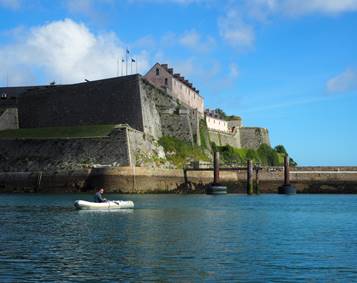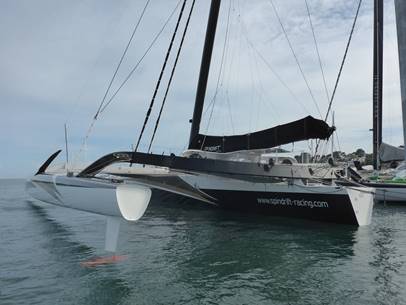10 June at La Trinite sur Mer

47:35.222N 003:01.551W We spent the morning of 9 June exploring the Citadelle de Vauban at Le Palais on Belle Ile. It dominates the harbour and was designed to keep the British out. It failed in that respect and having laid siege to it for a month, the French garrison surrendered in 1761 (not so long after the Battle Quiberon, as it happens). The British victors were suspicious of the motives of much of the Catholic population, who were deported en masse to Nova Scotia. But Belle Ile has an important place in the French psyche, so as part of the Treaty of Utrecht in 1763, it was swapped for Minorca (not Nova Scotia as reported previously. Note sent to RCC Pilotage Foundation) and several families returned, bringing the ubiquitous potato with them (and ‘Moule Frites was borne?).
Regardless of its merits as a warfighting facility, the Citadelle is beautifully kept and a terrific place to wander around. The grounds are immaculate and around each corner there is a surprise of some kind: a view of the harbour, a secret stairwell, a fine domed ceiling, a majestic staircase, or a place to just sit and reflect on life’s riches. We spent some of them in the town, buying soft furnishings of all things. There are not many opportunities for practising ‘feng shui’ in a yacht, so the only way to add a bit of individuality is either by fixing photographs of previous vessels (already done), or improving the comforts of the fairly firm foam seating. I really did not expect to find a bargain in this holiday island, but we did find a talkative, enthusiastic lady making a reasonable living out of interior design and ‘shabby chic’ with a pile of nautical or feline-themes cushions. Cats are for catching rats, so we opted for the anchors, wheels, fishes and liferings! And purchased a crab for the following day’s lunch.
There is a hotel inside the Citadelle… In the afternoon, we slipped quietly out of Le Palais and headed north across Quiberon Bay to the yachting mecca of La Trinité sur Mer. It was the home of the first French attempt to compete in the America’s Cup in the 1960s (not much progress, then) and has since developed into a major centre for the big racing trimarans that represent the ‘ultimate’ in high speed, long distance endurance racing. They are fantastic things to see at sea – often doing speeds of over forty knots with just one hull anywhere near the water (hydrofoils are the big thing this year) and in harbour they look like enormous waterboatmen. The marina staff gave us THE prime berth in the harbour, on the same pontoon as these monoliths, just opposite the busy quay with cafes and restaurants.
Spindrift: 40m long – note the hydrofoil on the rudder. Fantastic engineering and vision… We found ourselves next to a bunch of blokes in a motorboat. Not any old bunch and not any old motorboat either. Fred DuFlocq lives in Tahiti and bought ARIIMOANA (Tahitian for ‘King of the Seas) to circumnavigate the Americas via the Northwest Passage and Cape Horn. He’s off to Crosshaven in County Cork on Monday, then on to Greenland and into the ice in July. The boat carries an astonishing 4000 litres of diesel and rather a lot of foam insulation, but otherwise looks quite mundane. I told him about my friends Kev Oliver and Tony Lancashire, who did the Northwest Passage in 2009 in a 17 foot open boat under sail and oars. He was suitably impressed, before observing that they had two key advantages over ordinary folk in accomplishing feats of madness: being British and being Royal Marines. Yup. Fred’s blog is at blog/do On Saturday, surrounded by the most extraordinary examples of marine technology anywhere in the world, we set off to explore the prehistoric Menhirs of Carnac. I grew up reading Asterix the Gaul, but was not prepared for the scale of the site at Carnac, which stretches for some six kilometres at the main site and spreads out into the surrounding countryside for miles. Why did they do it? Nobody knows for sure (any more than many of my colleagues in the Royal Navy understand why people go sailing in such outlandish machines) so I enjoyed the link here between the old and the new in this wonderful part of southern Brittany. I favour some sort of connection between a fascination with the heavens and taking proper care of the dead; a spirituality which you do find amongst sailors in mid-ocean, but which is a million miles from the hustle and bustle of 21st century life. We ate crab sandwiches in the middle of an ancient forest alongside a 30 foot high Menhir; Perfect. We visited a rather dry and dull museum in the heart of Carnac itself, but then cheered up hugely at the sight of a local fireman getting married at the main church: a bagpipe and drum band, uniforms from a Beau Geste movie. We rushed off to a Patisserie for a cup of tea and a serious contender for the Tarte Citron Ultime… Just as well as we might not be in mainland France for much longer. On returning to the boat, we found Fred and his friends enjoying a pontoon party which they invited us to join. Two hour later, we escaped for dinner at a restaurant they recommended – Les Mouillages. We were not disappointed. The trimarans are off to St Nazaire shortly to race against Queen Mary 2 across the Atlantic to new York. What a sight that will be! The race starts around We’re going to set off across the Bay of Biscay and on to Phase 2 of our adventure: the North coast of Spain. |


